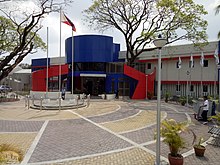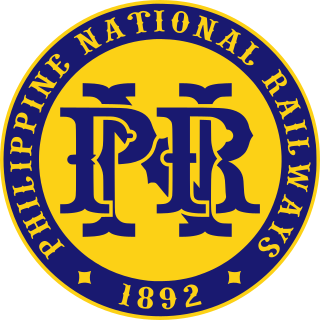
The Philippine National Railways (PNR) is a state-owned railway company in the Philippines which operates one commuter rail service between Metro Manila and Laguna, and local services between Sipocot, Naga and Legazpi in the Bicol Region. It is an attached agency of the Department of Transportation.

The Metro Rail Transit Line 3, also known as the MRT Line 3, MRT-3 or Metrostar Express, is a light rapid transit system line of Metro Manila, Philippines. Originally referred to as the Blue Line, MRT Line 3 was reclassified to be the Yellow Line in 2012. The line runs in an orbital north to south route following the alignment of Epifanio de los Santos Avenue (EDSA). Although it has some characteristics of light rail, such as the type of a tram-like rolling stock used, it is more akin to a rapid transit system owing to its total grade separation and high passenger throughput.
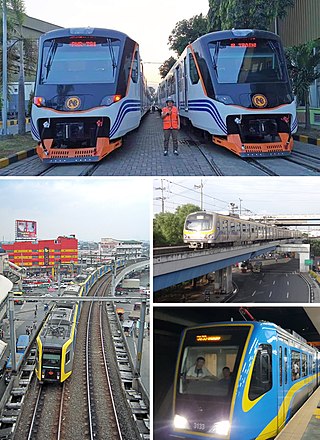
Rail transportation in the Philippines is currently used mostly to transport passengers within Metro Manila and provinces of Laguna and Quezon, as well as a commuter service in the Bicol Region. Freight transport services once operated in the country, but these services were halted. However, there are plans to restore old freight services and build new lines. From a peak of 1,100 kilometers (680 mi), the country currently has a railway footprint of 533.14 kilometers (331.28 mi), of which only 129.85 kilometers (80.69 mi) are operational as of 2024, including all the urban rail lines. World War II, natural calamities, underspending, and neglect have all contributed to the decline of the Philippine railway network. In the 2019 Global Competitiveness Report, the Philippines has the lowest efficiency score among other Asian countries in terms of efficiency of train services, receiving a score of 2.4, and ranking 86th out of 101 countries globally. The government is currently expanding the railway network up to 1,900 kilometers (1,200 mi) by 2022 through numerous projects.

The Department of Public Works and Highways, abbreviated as DPWH, is the executive department of the Philippine government solely vested with the Mandate to “be the State's engineering and construction arm” and, as such, it is “tasked to carry out the policy” of the State to “maintain an engineering and construction arm and continuously develop its technology, for the purposes of ensuring the safety of all infrastructure facilities and securing for all public works and highways the highest efficiency and the most appropriate quality in construction” and shall be responsible for “(t)he planning, design, construction and maintenance of infrastructure facilities, especially national highways, flood control and water resources development systems, and other public works in accordance with national development objectives,” provided that, the exercise of which “shall be decentralized to the fullest extent feasible.”

The Department of Tourism is the executive department of the Philippine government responsible for the regulation of the Philippine tourism industry and the promotion of the Philippines as a tourist destination.
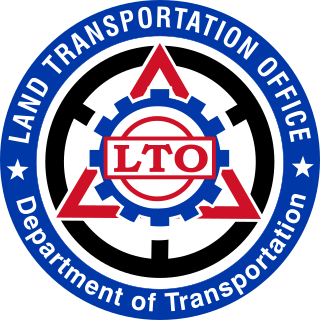
The Land Transportation Office is an agency of the Philippine government under the Department of Transportation responsible for all land transportation in the Philippines. Functions of the LTO include the inspection and registration of motor vehicles, issuance of licenses and permits, enforcement of land transportation rules and regulations, and adjudication of traffic cases.

The North Triangle Common Station, popularly known as the Common Station, is an under-construction rapid transit terminal and transport hub that will connect LRT Line 1, MRT Line 3, and MRT Line 7, and the nearby Metro Manila Subway. It is located in Bagong Pag-asa, Quezon City, Philippines, and is named after its location, which is at the corner of EDSA and North Avenue.

The transportation system in Metro Manila covers the road network, rail network, ferries, ports and airports located with the metropolitan Manila area. Road transportation in Metro Manila is diverse, composed of many types of private and public transport vehicles. These include Taxis, buses, jeepneys, tricycles and pedicabs. In some areas, especially in Divisoria and large public markets, two-stroke motors are fitted in the pedicabs and are used for goods transport. Regardless of modernity, horse-drawn kalesas are still used in the streets of Binondo and Intramuros. Ridesharing services such as Grab also operate within in Metro Manila.

The Manila Metro Rail Transit System (MRTS), commonly known as the MRT, is a rapid transit system that primarily serves Metro Manila, Philippines. Along with the Manila Light Rail Transit System and the Metro Commuter Line of the Philippine National Railways, the system makes up Metro Manila's rail infrastructure.

The PNR Metro Commuter Line is a commuter rail line operated by the Philippine National Railways. It was first inaugurated as the Metro Manila Commuter Service in 1970, and originally served the North Main Line and the South Main Lines, as well as the defunct Carmona and Guadalupe branch lines. Since then, it adopted several names such as Metrotrak and Metrotren, before adopting its present name in the late 2000s. The line is also nicknamed the Orange Line due to its designation in the 1970s.
The Metro Manila Dream Plan, formally titled the Roadmap for Transport Infrastructure Development for Metro Manila and Its Surrounding Areas, refers to a 2014 integrated plan for improving the transport system in Metro Manila, Philippines, with the hope of turning it into a focal point for addressing Metro Manila's interlinked problems in the areas of transportation, land use, and environment.

The Department of Information and Communications Technology (DICT) is the executive department of the Philippine government responsible for the planning, development and promotion of the country's information and communications technology (ICT) agenda in support of national development.

Herminio "Sonny" B. Coloma Jr. is a Filipino businessman and educator. He was a member of the Philippine Cabinet and Secretary of Presidential Communications Office during the presidency of Benigno S. Aquino III. He is also a professor at the Asian Institute of Management.
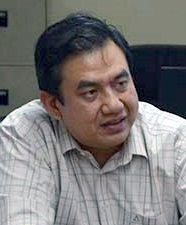
Thomas "Tim" Muñoz Orbos is a Filipino businessman, government administrator and politician who was General Manager of the Metropolitan Manila Development Authority (MMDA) and Undersecretary for Road Transport and Infrastructure of the Department of Transportation under the Duterte administration. He also served as MMDA's acting chairman following the resignation of Emerson Carlos on August 19, 2016. Orbos previously held the position of MMDA Assistant General Manager for Planning under then President Benigno Aquino III.
The Metro Manila Subway, formerly known as the Mega Manila Subway (MMS), is an under-construction underground rapid transit line in Metro Manila, Philippines. The 36-kilometer (22 mi) line, which will run north–south between Valenzuela, Quezon City, Pasig, Taguig, Parañaque and Pasay, consists of 15 stations between the East Valenzuela and Bicutan stations. It will become the country's second direct airport rail link after the North–South Commuter Railway, with a branch line to Ninoy Aquino International Airport.

The North–South Commuter Railway (NSCR), also known as the Clark–Calamba Railway, is a 147-kilometer (91-mile) urban rail transit system under construction in the island of Luzon, Philippines. Running from New Clark City in Capas to Calamba, Laguna with 36 stations and four services, the railway is designed to improve connectivity within the Greater Manila Area, and it will be integrated with the railway network in the region.

Light Rail Manila Corporation (LRMC) is a rail service company based in Pasay, Metro Manila, Philippines. It is a consortium of companies engaged in the operation and maintenance of the Manila Light Rail Transit System Line 1 since September 2015. The consortium is composed of Metro Pacific Investments Corporation and Sumitomo Corporation's Metro Pacific Light Rail Corp. (MPLRC); AC Infrastructure Holdings Corp. ; and Macquarie Infrastructure Holdings (Philippines) Pte. Ltd.
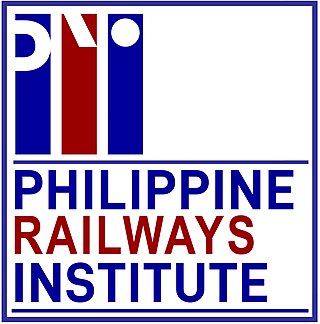
The Philippine Railways Institute (PRI) is a rail transportation research and training center in the Philippines. It deals with research and development on the management, operation, and maintenance of railways, and training of personnel in the rail transportation industry.

Rail transportation in the Greater Manila Area is a major part of the transportation system in Metro Manila and its surrounding areas. It consists of the Manila Light Rail Transit System, Manila Metro Rail Transit System, and the PNR Metro Commuter Line. The network makes up the majority of active railways in the country and bear the brunt of providing the metropolis with rail as a faster alternative mode of transport other than buses and jeepneys. However, these systems are currently insufficient for the rapidly expanding metropolis; to address this, new lines and line extensions are under construction, which will extend the system far out into neighboring regions.

The PNR EM10000 class is an electric multiple unit commuter trainset that will be operated by the Philippine National Railways on the North–South Commuter Railway. Prior to the reveal of its numbering scheme in October 2021, the train was known as the PNR Sustina Commuter. Set to enter service by 2023, it will be PNR's first trainset to be run on standard gauge and powered by electric traction. The trains are also designed to be interoperable with the Metro Manila Subway.

